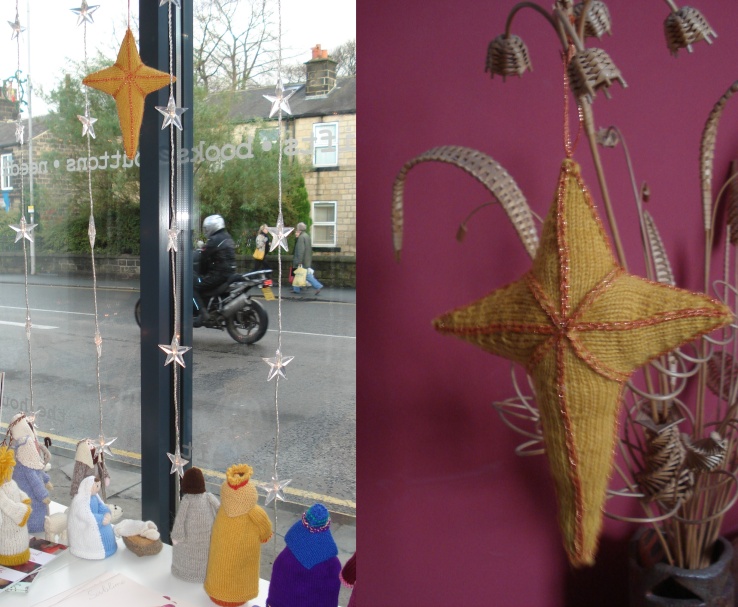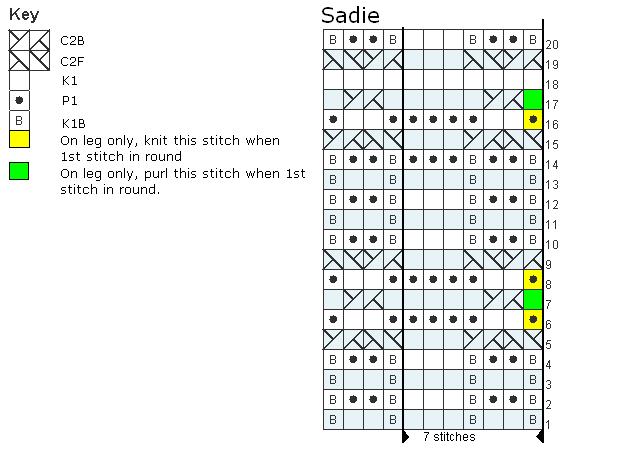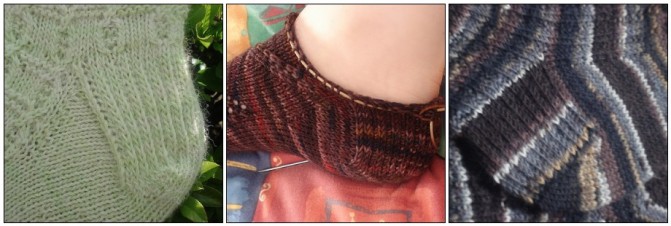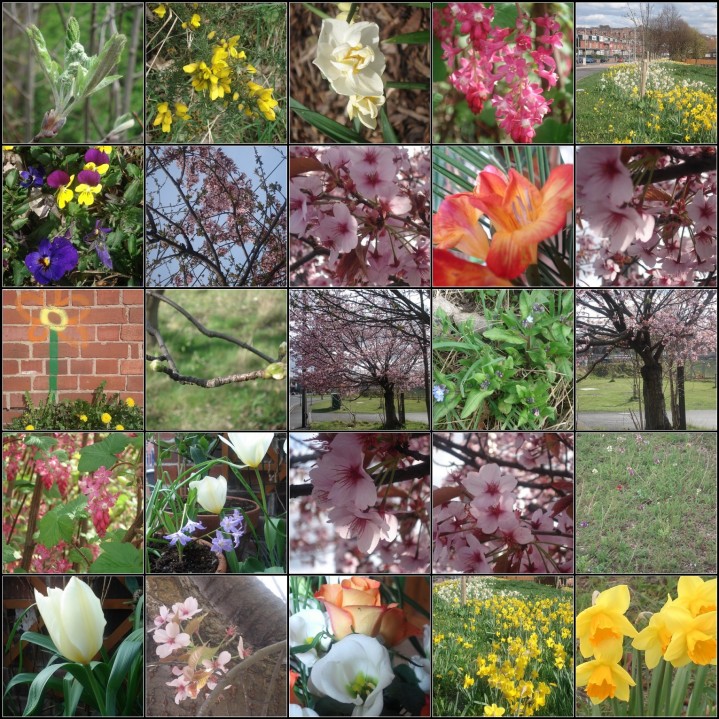I designed this simple geometric star for the BaaRamEwe Christmas window display, a Jean Greenhowe knitted nativity set made by the BaaRamEwe knit night crew.
In keeping with the shop theme (Yorkshire yarns and British breeds), I’ve used pure Blue-faced Leicester DK for the star and Twilleys Goldfingering for the optional embellishment. You could substitute for almost any yarn, just remember that as with any stuffed item you’ll need a needle size a little smaller than usual so the fabric is nice and dense. I used a circular needle, or dpns would work, especially for the fiddly bits at the centre front and back of the star.
The star looks great as a hanging ornament, or with a little adaptation it could be made into a tree-topper.
Star of Bethlehem:
Materials:
British Breeds Yarns Blue Faced Leicester Double Knitting, shade 629 (yellow), 1 ball.
Twilleys of Stamford Goldfingering, shade 64 (orange), 1 ball.
3.25mm circular needle, 60cm or longer.
Stitch markers (optional).
Needle.
Toy stuffing.
Abbreviations:
k = knit
p = purl
kfb = knit into front and back of the same stitch
sl = slip next stitch with yarn at the back of the work – all slipped stitches are worked purlwise unless otherwise stated
k2tog = knit 2 stitches together
triple dec = slip 2 stitches together as if to k2tog, knit next stitch through the back of the loop, then pass the slipped stitches over (2 stitches decreased)
Instructions:
Small Point (make 3)
Cast on 4 stitches and slip them to the other end of the needle. Start knitting the next row from the first cast on stitch as if making an i-cord.
Round 1: place marker if required to mark start of round. kfb, repeat to end of round (8 stitches).
Round 2: [sl, k] to end of round.
Round 3: k all.
Round 4: [sl, k] to end of round.
Round 5: [k, kfb] to end of round (12 stitches).
Round 6: [sl, k2] to end of round.
Round 7: k all.
Round 8: [sl, k2] to end of round.
Round 9: [k2, kfb] to end of round (16 stitches).
Round 10: [sl, k3] to end of round.
Round 11: k all.
Round 12: [sl, k3] to end of round.
Round 13: [k3, kfb] to end of round (20 stitches).
Round 14: [sl, k4] to end of round.
Round 15: k all.
Round 16: [sl, k4] to end of round.
Round 17: [k4, kfb] to end of round (24 stitches).
Round 18: [sl, k5] to end of round.
Round 19: k all.
Round 20: [sl, k5] to end of round.
Round 21: [k5, kfb] to end of round (28 stitches).
Round 22: [sl, k6] to end of round.
Round 23: k all.
Round 24: [sl, k6] to end of round.
Round 25: [k6, kfb] to end of round (32 stitches).
Round 26: [sl, k7] to end of round.
Round 27: k all.
Round 28: [sl, k7] to end of round.
Break yarn and thread stitches onto waste yarn.
Large Point (make 1)
Rounds 1-8: Same as on Small Points (12 stitches).
Round 9: k all.
Round 10: [sl, k2] to end of round.
Rounds 11-12: repeat Rounds 9-10.
Round 13: [k2, kfb] to end of round (16 stitches).
Round 14: [sl, k3] to end of round.
Round 15: k all.
Rounds 16-19: repeat Rounds 14-15 twice.
Round 20: [sl, k3] to end of round.
Round 21: [k3, kfb] to end of round (20 stitches).
Round 22: [sl, k4] to end of round.
Round 23: k all.
Rounds 24-27: repeat Rounds 22-23 twice.
Round 28: [sl, k4] to end of round.
Round 29: [k4, kfb] to end of round (24 stitches).
Round 30: [sl, k5] to end of round.
Round 31: k all.
Rounds 32-25: repeat Rounds 30-31 twice.
Round 36: [sl, k5] to end of round.
Round 37: [k5, kfb] to end of round (28 stitches).
Round 38: [sl, k6] to end of round.
Round 39: k all.
Rounds 40-43: repeat Rounds 38-39 twice.
Round 44: [sl, k6] to end of round.
Round 45: [k6, kfb] to end of round (32 stitches).
Round 46: [sl, k7] to end of round.
Round 47: k all.
Rounds 48-51: repeat Rounds 46-47 twice.
Round 52: [sl, k7] to end of round.
Thread the last 15 stitches worked onto waste yarn without breaking the working yarn.
Centre 1 (can be either back or front):
Assemble points of star as follows:
Working across the Large Point, sl first stitch, ** k15, sl next stitch knitwise.
Take one of the Small Points, and slide 17 stitches onto your left needle point, starting and ending with one of the slipped (corner) stitches of the points. Sl first stitch knitwise, then insert left needle point into the front of the first 2 stitches on the right needle and knit them together. **
Repeat from ** to ** 3 more times. The final time you will be joining the 3rd Small Point back to the Large Point (64 stitches in round). K7 to the new start of the round – place marker if necessary to mark new start of round.
Round 1: [sl, k6, triple dec, k6] to end of round (56 stitches).
Round 2: k all.
Round 3: [sl, k5, triple dec, k5] to end of round (48 stitches).
Round 4: k all.
Round 5: [sl, k4, triple dec, k4] to end of round (40 stitches).
Round 6: k all.
Round 7: [sl, k3, triple dec, k3] to end of round (32 stitches).
Round 8: [k3, triple dec, k2] to end of round (24 stitches).
Round 9: [sl, k1, triple dec, k1] to end of round (16 stitches).
Round 10: [k1, triple dec] to end of round (8 stitches).
Break yarn and thread through the final 8 stitches. Secure yarn on wrong side of work and darn in yarn ends from points. Part stuff each point.
Centre 2:
Cut waste yarn lengths and work remaining stitches from points as follows, starting with the centre (slipped) stitch on any point:
[k8, pick up 2 stitches between points and knit together, k7] to end of round (64 stitches).
Repeat from Round 1 of Centre 1, adding small amounts of stuffing as you go and ensuring the star is fully stuffed before the centre hole gets too small.
Secure any remaining yarn ends and hide on the inside.
Optional embellishment:
Using sparkly thread and duplicate stitch (Swiss darning), oversew the outline of the star, the centre stitches of each point on both sides, and the diagonals on both sides (basically every place you were slipping stitches or decreasing while knitting).
Make a loop of plaited, twisted or crocheted thread at the top point of the star (opposite the Large Point!). Display, and enjoy.
{Puzzle – starting from a point of the star, with an extremely long thread it would be possible to do all the oversewing in 1 continuous line. Can you work out how?}








 Pattern Stitch: (over 7 stitches and 20 rows). Final 4 stitches after the pattern repeat are for the foot only.
Pattern Stitch: (over 7 stitches and 20 rows). Final 4 stitches after the pattern repeat are for the foot only.





